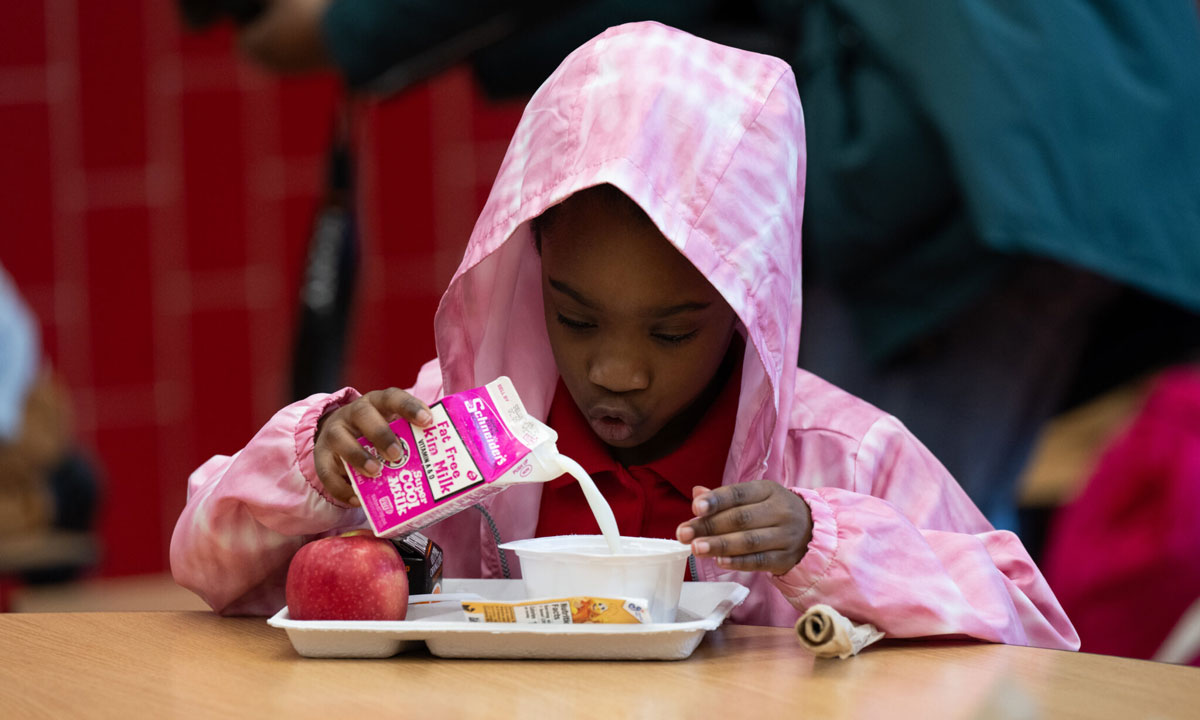Researchers Find Unlikely Allies in Improving Kids’ Eating Habits: iPads & Anime
Muscle Max and Trans Fat Cat get third graders thinking about Pringles and Sour Patch Kids.

Get stories like this delivered straight to your inbox. Sign up for The 74 Newsletter
An animation of a young guy with floppy brown hair shows him in a plain white tee, grinning as lightning cracks in the distance.
“I’m Max. Muscle Max,” he says. “How did I get so totally in shape? Lots of exercise, and protein from meats, beans and milk.”
Muscle Max is from “Body Quest: Food of the Warrior,” created by a team at Auburn University, part of the Alabama Cooperative Extension System, as an obesity prevention effort aimed at grade schoolers. Muscle Max is one of six anime-styled characters — like Body Doctor, who is a Black girl samurai and avid eater of fruit, and Shining Rainbow, who likes veggies for their vibrant color — who also visited some Rhode Island schools as part of a research study led by Kate Balestracci at the University of Rhode Island (URI).
Balestracci is the program manager of SNAP-Ed at URI, the nutrition education component of the Supplemental Nutrition Assistance Program (SNAP), which is run by the U.S. Department of Agriculture (USDA). Balestracci also leads Children, Youth, and Families at Risk (CYFAR), another USDA initiative, at URI.
A new article in the Journal of Nutrition Education and Behavior recaps the quantitative results from Balestracci’s USDA-funded study, which brought one-hour weekly classes — usually swapped in for an existing health class — to six different schools in Rhode Island over three years. As is typical for research studies, the schools are not identified directly, but they are cited as being from lower-income school districts.
There were 242 third graders in the control group, who received no special programming. The 217 third graders in the intervention group received the “Body Quest” curriculum — something created as part of Alabama’s own SNAP-Ed program, Live Well Alabama. The curriculum involves printed materials and in-class activities and discussions, with the centerpiece being an iPad app loaded with games to encourage healthy eating.
When asked about the timeline of the new research in a recent phone interview, Balestracci laughed and noted it wasn’t that new. The articles took a while to complete, she said, and the actual classroom sessions took place between 2015 and 2018. A qualitative article on the same research came out first in 2019 and included interviews with the third graders.
“The thing is, with kids, hard data like pre-, post-quantitative data, [it’s] pretty hard to get accurate information,” Balestracci said. “They just are arbitrary, or they don’t really know. But when it comes to qualitative, they speak their mind very well. So that actually I think is a little more valuable sometimes.”
Data collection for the quantitative study centered on student surveys with questions like: “How many times did you drink a sugary drink yesterday?” or “How many times did you eat a salty snack yesterday between your meals?” The results show that the intervention students sipped fewer sugary drinks, didn’t consume as many salty snacks and ate more fruit. Intake of vegetables and sweet snacks, however, barely changed.
“Sweet snacks are often desserts, which kids are maybe less likely to swap out for a fruit,” Balestracci said. “But salty snacks, like Takis or chips — sometimes kids are OK with decreasing that and having a healthier choice for snack.”

But what about snacking outside of school?
Balestracci’s study may have been conducted some years ago, but the research is still relevant. At a March 7 meeting of the Rhode Island House Committee on Finance, the night’s hottest topic of discussion was inarguably Rep. Justine Caldwell’s bill to provide free school meals for all public school students regardless of income. In Balestracci’s studies, both intervention and control schools had just under 90% eligibility for free or reduced lunch.
A testimony in support of Caldwell’s bill came from Geoffrey Greene, Balestracci’s colleague at URI and a co-author on the new study. Lunchboxes from home may be packed with love — but Greene noted in his testimony that his research shows they are generally less healthier than those served at school.
“In Rhode Island, we have to rely on the Healthy Schools Coalition that has quite stringent food policy guidelines for the state and for the school that participate in school meals,” Balestracci said.
But she said snacking outside of school is much less governable: “No corner store is gonna stop a child from buying something,” Balestracci added.
Ideally, corner stores would stock more fresh fruits alongside Pringles and Sour Patch Kids — but Balestracci acknowledged the challenges of supply chain issues and the demand it would create on small businesses.
One of the study’s limitations, the article noted, was that it only accounted for weekday eating habits — and weekends tend to be filled with vice. Students’ eating habits could definitely differ on the weekend, said Balestracci: “That could be a whole different ballgame. It’s everyone’s different ballgame.”
The URI researchers used a retooled version of the “Body Quest” curriculum, since the original didn’t devote much coverage to sugary drinks or energy–dense snacks.
“While eating fruits and vegetables is great, it doesn’t necessarily replace the other things that they’re having,” Balestracci said.
Information on “Body Quest” was still available on the SNAP-ed national website as of late February, but by March 13 the page returns an error message. Requests for comment from both Alabama Cooperative Extension System and the national SNAP-Ed office went unreturned. The “Body Quest” handbook and classroom materials are still available on the Extension System website. The iPad app, which was last updated in 2022, is on Apple’s App Store.
Still present in Balestracci’s remade curriculum was Trans Fat Cat — the ostensible villain of “Body Quest,” who is not really sinister but rather injudicious in his dietary habits.
Alas, change is possible, even with picky eaters.
“I just have one thing to say, is that when I was little, I didn’t wanna eat yogurt. I didn’t like yogurt,” one student in the 2019 qualitative study said. “Now, I’m eating the whole cup of yogurt.
Rhode Island Current is part of States Newsroom, a nonprofit news network supported by grants and a coalition of donors as a 501c(3) public charity. Rhode Island Current maintains editorial independence. Contact Editor Janine L. Weisman for questions: info@rhodeislandcurrent.com. Follow Rhode Island Current on Facebook and Twitter.
Get stories like these delivered straight to your inbox. Sign up for The 74 Newsletter

;)